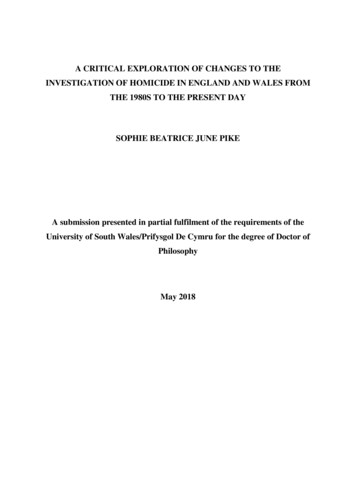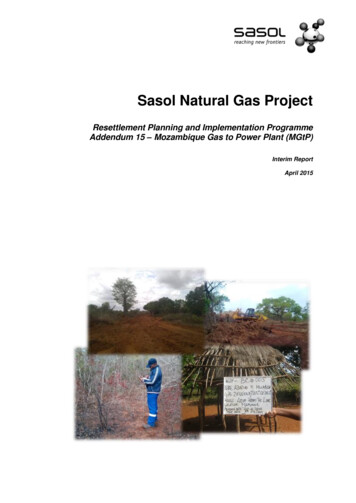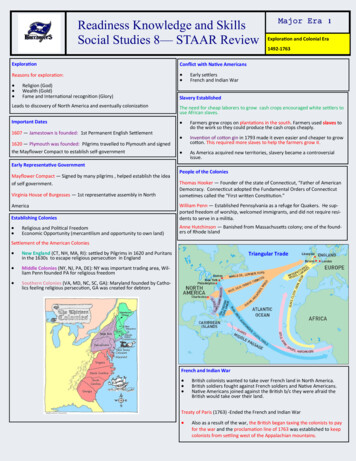
Transcription
A CRITICAL EXPLORATION OF CHANGES TO THEINVESTIGATION OF HOMICIDE IN ENGLAND AND WALES FROMTHE 1980S TO THE PRESENT DAYSOPHIE BEATRICE JUNE PIKEA submission presented in partial fulfilment of the requirements of theUniversity of South Wales/Prifysgol De Cymru for the degree of Doctor ofPhilosophyMay 2018
AbstractThe six-year investigation by West Yorkshire Police to apprehend Peter Sutcliffe, theYorkshire Ripper, in the late 1970s and early 1980s was roundly criticised and led to a publicinquiry that called for wide-ranging changes to homicide investigation. With a historyalready marred by corruption and miscarriages of justice, it was a pivotal case, whichtriggered a process of reform that has continued to the present day.Yet, flawedinvestigations continue, suggesting that the investigation of homicide remains fallible.Moreover, the homicide detection rate has declined since the 1960s. Despite this, homicideinvestigation is a topic that has been subject to minimal academic scrutiny. This studyaddresses this gap by exploring how and why the investigation of homicide in England andWales has changed since the 1980s and what has been lost and/or gained as a consequence.Adopting a qualitative approach, the research is based on in-depth interviews with twentyseven former and serving homicide detectives, the analysis of three police murder files fromthe 1980s, 1990s and 2000s, and observations of homicide investigation and detectivetraining.Original documentation from the Yorkshire Ripper investigation was alsoexamined.This research has established that homicide investigation has changed almost beyond allrecognition across the last four decades. This is the consequence of four central drivers: agrowing preoccupation with risk; the changing political economy; reactions to miscarriagesof justice or problematic cases; and advances in science and technology. The impact ofchange has been considerable and whilst there have been benefits, today’s more risk aversehomicide detectives face new challenges that are compounded by cuts to police budgets andprioritisation of other crimes such as terrorism.2
AcknowledgementsTo my supervisors, Professors Fiona Brookman and Mike Maguire, a heartfelt thank you foryour unwavering support and guidance. You have made the challenge of completing a PhDan enjoyable one and I really am going to miss our supervision meetings. Thank you also forhelping me to lay the foundations for my future academic career by encouraging me to pursueother exciting opportunities along the way. I have learnt so much and simply could not haveasked for better supervisors.Those who participated in my research must of course remain anonymous, but they eachdeserve an enormous thank you for giving me so many hours of their valuable time and suchfantastic insight into their world. I have thoroughly enjoyed meeting and speaking to everyone of you.Thank you to the team at the University of South Wales (formerly University of Glamorgan)Centre for Criminology. When I joined the university as an undergraduate in 2007 I couldnever have dreamed that I would still be here ten years later having completed a PhD. It isbecause of you that I was able to take that step and your encouragement over the years hasbeen more than I could ever have asked for. A special thank you to Dr Cheryl Allsop - youwere right, it did all come together!The biggest thank you to my family and friends, four legged and otherwise (especiallyMunchkin!). To mum and dad, had you not supported me when I decided to give up full-timework and go to university, I would not be in this fantastic position and for that I will beforever grateful. To Olivia, Luke and baby Nancy, thank you for keeping a roof over myhead, keeping me fed and encouraging me when I was in serious procrastination mode!Thanks to Ben, Josey, Nathan and Kate for providing me with R and R in Scotland when Ineeded it. Thank you also to my Nan for proof reading some of the chapters and doing awonderful job. An enormous thank you to my fabulous friends, Olivia, Michelle, Hannahand Sara for always being on hand to make sure I took a holiday and helping me to celebratethe mini victories.Finally, this research would not have been possible had I not received one of the Universityof Glamorgan’s Centenary Scholarships. Thank you.3
ContentsChapter One - Introduction . 8The Need to Pursue all Lines of Enquiry . 8The Present Research. 10Thesis Structure . 10Part One - The Research Backdrop . 13Chapter Two - The Changing Face of Homicide Investigation: History andExplanations of Change. 14From The Birth of Criminal Investigation to an Alleged ‘Golden Age’ of Policing andthe Rise of Scandal . 14The Post-War Period: A ‘Golden Age’ of Policing? . 16Rising Scandal . 17Policing and Change . 18Thatcher, Efficiency and a Privileged Police Force . 18The Yorkshire Ripper and The Byford Inquiry 1981 . 20The Police and Criminal Evidence Act 1984 (PACE) . 21‘Value for Money’ and the Performance Culture . 25Introducing Models of Interviewing . 28The Criminal Procedure and Investigations Act 1996 (CPIA) . 30New Labour, the Macpherson Report and Further Legislation . 33The Professionalising Investigation Programme (PIP) . 37Late Modernity and Risk . 40The Current Picture . 43Explaining Change . 45Conclusion . 50Chapter Three - A Review of the Technological and Scientific Advances in HomicideInvestigation . 52The Use of Science and Technology in Criminal Investigation: A Brief History . 52Deoxyribonucleic Acid (DNA) . 54The Pitchfork Case . 55The National DNA Database (NDNAD) . 56The Home Office Large Major Enquiry System (HOLMES) . 58Passive Data Sources . 60Closed Circuit Television (CCTV) . 60Communications Data . 63The Role of Science and Technology in Homicide Investigations . 65Art, Craft, Science and Detective Culture . 68Conclusion . 70Chapter Four - Illuminating the World of Homicide Investigation and the Detective . 71A Qualitative Approach . 714
Interviews: Capturing the Past and Present . 72Pilot Interviews . 74Identifying Former and Serving Homicide Detectives . 75Interviewing Former and Serving Detectives: In Practice. 77Asking Interviewees to Look Back . 79Asking Difficult Questions . 80An Alternative Perspective . 81Protecting Investigations: The Censorship of Interview Transcripts . 82Examining Police Murder Files: Getting the Written Perspective . 83The Yorkshire Ripper Archive . 86Observations: A Firsthand Look at Investigations Today and a Glimpse into the Past. 86Senior Investigating Officer Training. 88A Major Crime Investigation Team at Work. 89Analysing the Data . 91Ethical Issues: The Unpredictable Nature of Research . 93An Ethical Dilemma . 94Researcher Welfare. 95Conclusion . 95Part Two - The Research Findings . 96Chapter Five - ‘It can be easy now to forget that you’ve got to find the actualmurderer’: The Day-to-Day Running of Homicide Investigations . 98A Well-Oiled Machine?. 98A Question of Experience: Civilian Investigators . 102From Securing Confessions to Models of Interviewing . 104‘Getting it wrong is so much more costly’: Budget and Homicide Investigation . 107‘I don’t think you can do it all’: The SIO, Their Team and The Role of Experts . 109Learning from Past and Present Homicide Investigations. 113Perspective and Change . 117Conclusion . 119Chapter Six - ‘It wasn’t leeway it was carte blanche. They were nigh on out of control’:Regulating Investigations and Investigators . 121From the Judges’ Rules to PACE: A Necessary Change . 121Regulating Disclosure: The Criminal Procedures and Investigations Act 1996 (CPIA) 127A Question of Rights: The HRA 1998 and RIPA 2000 . 131The Role of Guidance: The Murder Investigation Manual . 133Bureaucracy, Risk Aversion and Human Error . 137Legislation, Regulation and Guidance as Support. 141Conclusion . 142Chapter Seven - ‘The possibilities became endless overnight’: Advances in Science andTechnology . 144Science and Technology in the Past: The Detectives’ Perspectives . 1445
The Increased Volume of Information . 146Science and Technology on Trial . 152A Question of Detective Skills? . 156Lagging behind? The Impact of Continually Evolving Science and Technology . 159Doing More with Less: The Impact on Budget . 162Conclusion . 165Chapter Eight - ‘The most accurate thing I have ever seen is ‘Life on Mars’’: ChangingDetective Status and Culture . 166The Loss of Kudos . 166A Decline in Recruitment . 169The Changing Detective Culture . 171From Police Bars to Coffee Bars . 172‘We Need to Get our Man’: Feared SIOs and Tunnel Vision . 174Today’s SIO . 177The Female Detective . 180The Professionalisation of Detective Training . 182Conclusion . 188Part Three - The Discussion . 189Chapter Nine - Explaining Change . 190A Myriad of Changes . 190Explaining Changes to the Investigation of Homicide in England and Wales . 193A Preoccupation with Risk . 195The Changing Political Economy . 196Reactions to Miscarriages of Justice and Problematic Investigations . 200Advances in Science and Technology . 205Conclusion . 208Chapter Ten - The Impact of Four Decades of Change: Opportunities and Challenges. 210Opportunities . 210Challenges . 211A Past and Present Problem: Information Overload . 212The Loss of Traditional Detective Skills . 213The Risk Averse Detective . 214The Diminishing Status of the Detective . 219Diminishing Resources and New Priorities . 221The Obstinate Detection Rate . 223Have Lessons Been Learned? . 224The Research Questions Revisited and Future Research . 225An End Note. 227References . 228Appendix One Pilot Interview Schedule . 2556
Appendix Two - Research Overview . 257Appendix Three - Interview Schedule for Former Detectives . 258Appendix Four - Interview Schedule for Serving Detectives . 262Appendix Five - Interview Schedule QC . 266Appendix Six - Emailed questions to QC. 2687
Chapter OneIntroductionIn 1981 Peter Sutcliffe, a lorry driver from Yorkshire in England, was arrested for themurders of thirteen women and attacks on seven others (Bilton, 2012). The arrest of the man,known as the Yorkshire Ripper, signalled the end of a six-year investigation by WestYorkshire Police that had been beset by criticism. The Byford Inquiry that was established toreview the investigation identified problems in numerous areas (Byford, 1981). In particular,limitations within the Major Incident Room (Byford, 1981), which had been overwhelmed bythe volume of information that the inquiry had generated, were identified as leading to missedopportunities to apprehend Sutcliffe (Wattis, 2017). The investigation was also hampered bythe lack of a computerised system on which to store the masses of information (Byford,1981).The extensive recommendations that emerged from the Inquiry heralded an importantmoment in major crime investigation, for its changes have “governed all major crimeinvestigations since” (Brain 2010, p63). This was the first time that homicide investigationhad come under considerable scrutiny and reform, but it would not be the last. Over the pastfour decades major crime investigation in England and Wales has been subject to almostcontinual change. However, high-profile miscarriages of justice and cases in which policework has been criticised cannot be considered the preserve of the past and continue to occur.The Need to Pursue all Lines of EnquiryWidely regarded as one of the most heinous crimes, homicide attracts a significant amount ofacademic, media and public interest (Brookman et al., 2017a).Whilst the media areundoubtedly interested in all forms of crime, there is a tendency to focus upon those that areparticularly violent and serious in nature, especially homicide. Reiner (2007) writes that thishas been the case for many years.As such, the public are equipped with a “degree of knowledge about personal and socialphenomena of which very few have ever, or are ever likely to experience” (Innes 1999,p272). Further, homicide is considered to be a ‘signal crime’, which is defined by Innes(2013, p52) as an event that will “impact in some way upon a wider audience”. It is becauseof this, Stelfox (2015) argues, that the public hold high expectations about the way in which8
the police deal with these crimes, something that will undoubtedly be fuelled by theprevalence of documentaries following homicide investigation teams 1. These expectationsare not always met. The flawed investigations into the murders of Stephen Lawrence,Damilola Taylor, Holly Wells and Jessica Chapman are examples.Despite this, homicide investigation and detective work remain relatively neglected by theresearch literature (Brookman and Innes, 2013; Stelfox, 2015). There are several potentialexplanations for this. Firstly, the number of homicides perpetrated in England and Wales isamong the lowest in the world (Brookman et al., 2017b) with the Office for NationalStatistics (ONS) reporting that for the year ending March 2016 there were 571 cases ofhomicide recorded (ONS, 2017); thus it might be said that more prevalent crimes warrantattention. Secondly, the detection rate for homicide suggests that the police are successful atinvestigating them; according to Brookman et al (forthcoming) in England and Wales thatrate has been around 90% since 2000. This is partially attributable to the fact that themajority of homicides in England and Wales can be described as ‘self-solvers’ whereby theoffender is swiftly identified (Innes, 2003). However, the detection rate has declined from anaverage of 94% during the 1960s (Brookman et al., forthcoming). Thirdly, methodologicalchallenges might prohibit those who wish to research homicide investigation, whichBrookman (2015, p236) describes as a “closed world”.Whilst there are notable exceptions (Allsop, 2012; Brookman and Innes, 2013; Brookman etal., forthcoming; Hobbs, 1988; Stelfox, 2015), these works focus on particular aspects ofhomicide investigation. Allsop (2012) examined police cold case investigations, Brookmanand Innes (2013) explored what constitutes success in a homicide investigation and Hobbs(1988) looked at detective culture. Some research has aimed to explore change. Stelfox(2015) writes about the development of homicide investigation to identify where savingsmight be made in light of funding cuts, stressing that an understanding of the publicexpectation in respect of homicide investigations must be maintained. In his book exploringwhy changes in policing have taken place, Savage (2007) suggests that failings in majorcrime investigations have been responsible for driving change. These works, however, arenot empirically grounded. Moreover, much of the empirical research that has been conducted1At the time of writing ITV aired a documentary following Northumbria Police as they investigated amurder. Entitled ‘An Hour To Catch a Killer’ it might be said that this could influence publicexpectations about the realties of investigating homicide and the timescales involved.9
originates in the US (Brookman, 2015) rather than England and Wales. In addition, thisresearch is often quantitative as opposed to qualitative.Evidence of the necessity for such research is easy to find. In addition to certain cases starklyillustrating that major crime investigation remains imperfect, the police service hasexperienced significant budget cuts (Her Majesty’s Inspectorate of Constabulary (HMIC),2014) and there are shortages in the number of detectives (HMIC, 2017). This illustrates theimportance of including a present day perspective.Homicide investigation is in need of closer attention. Yet, what has not been achieved by theexisting literature is a qualitative exploration of the changes to homicide investigation inEngland and Wales that begins when major crime investigation was placed under thespotlight and continues to the present day. This would ensure an understanding of theconsequences of change, and what they might mean for the future of these investigations.The Present ResearchThis research explores the changes that homicide investigation has endured and how theyhave impacted upon investigations and detectives, using a qualitative approach. Former andserving homicide detectives were interviewed to gain insight from those working on theground. Analysis of homicide case files, including original paperwork from the YorkshireRipper investigation, and observations of investigations and detective training, further enrichthe study.This work will provide a holistic examination of the recent history of homicide investigationin England and Wales, with a contemporary discussion of the issues now facinginvestigations and detectives. Accordingly, the core research questions are:1. In which particular ways have the investigation of homicide in England and Waleschanged since the 1980s?2. Why has the investigation of homicide changed?3. What is the impact of change upon the investigation of homicide and the homicidedetective?Thesis StructureThe remainder of the thesis is divided into three parts, set out as follows:10
Part One: The Research BackdropChapter Two provides an overview of the key events and changes that have shaped theinvestigation of homicide in England and Wales.Chapter Three considers the extensive scientific and technological advances that have takenplace across the last four decades. I also discuss the apparent shift from detective work beingviewed as ‘art’ or ‘craft’ to one of ‘science’.In Chapter Four I reflect upon the data collection process, detailing how the interviews andobservations were conducted, and homicide case files analysed.Part Two: The Research FindingsChapter Five explores the changes that have shaped the day-to-day running of homicideinvestigations. It will be shown that investigations have grown increasingly complex andtoday’s detective must manage a myriad of investigative strands.Chapter Six considers the growth in legislation, regulation and guidance for homicideinvestigations and investigators. Here it will become apparent that while such change hasprovided detectives with support, it has led to them becoming risk averse.In Chapter Seven the opportunities and challenges that substantial technological andscientific change have presented to today’s detective are discussed.Chapter Eight, the final findings chapter, considers the changing detective status and culture.It will be shown that the modern-day detective bears little resemblance to their predecessorand what has been lost and gained as a result is considered.Part Three: The DiscussionIn Chapter Nine it will be shown that the investigation of homicide in England and Wales hasbeen subject to extensive change and that this has been the result of multiple influences at asocietal and organisational level. Four key drivers of change are presented and the changesthat they have driven discussed.Finally, in Chapter Ten I consider the impact of change and demonstrate that change has notbeen wholly beneficial. I argue that the consequences of change must be carefully reviewed,since those that have been implemented since the 1980s, have not solved many of the11
problems that were identified in the past or led to any significant increase in the detection rateand have left the role of the detective a relatively unappealing prospect.12
Part OneThe Research BackdropIn the introduction to this thesis it was established that homicide investigation in England andWales has been subject to continuous reform since the 1980s. Accordingly, it is the aim ofChapters Two and Three in this part to outline the key developments that have shaped theseinvestigations to provide the backdrop to the current research. In Chapter Two a brief historyof policing and homicide investigation is presented and it will become apparent that theextent of change has been considerable. Here the current explanations for change are alsodiscussed. The intention of Chapter Three is to explore the scientific and technologicaladvances that have also played a role in changing homicide investigations. Developments inscience and technology have been extensive so they have been assigned their own chapter.Despite such extensive change the role that science and technology plays in investigations isnot fully understood (see, for example, Brady and King, 2017). It will be demonstrated thatthese changes have been advantageous in the investigation of homicide, but also generatednew challenges for the modern-day detective. Finally, in Chapter Four attention turns to thepresent study and the reader will gain insight into how the research was conducted. The useof in-depth qualitative interviews, case file analysis and observations are each discussed indetail, before I end with consideration of the ethical issues and the sometimes unpredictablenature of research.13
Chapter TwoThe Changing Face of Homicide Investigation: History and Explana
the 1980s, 1990s and 2000s, and observations of homicide investigation and detective training. Original documentation from the Yorkshire Ripper investigation was also examined. This research has established that homicide investigation has changed almost beyond all recognition across the last four decades.











